technical specifications Alfa Romeo MiTo 2021 Owner handbook (in English)
[x] Cancel search | Manufacturer: ALFA ROMEO, Model Year: 2021, Model line: MiTo, Model: Alfa Romeo MiTo 2021Pages: 212, PDF Size: 5.18 MB
Page 7 of 212
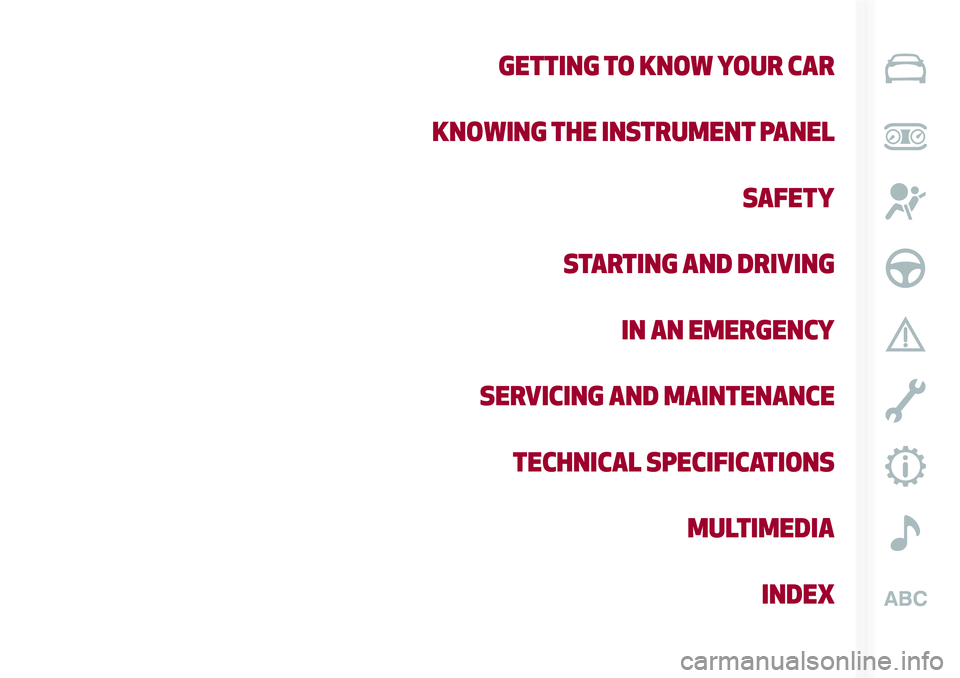
GETTING TO KNOW YOUR CAR
KNOWING THE INSTRUMENT PANEL
SAFETY
STARTING AND DRIVING
IN AN EMERGENCY
SERVICING AND MAINTENANCE
TECHNICAL SPECIFICATIONS
MULTIMEDIA
INDEX
Page 56 of 212
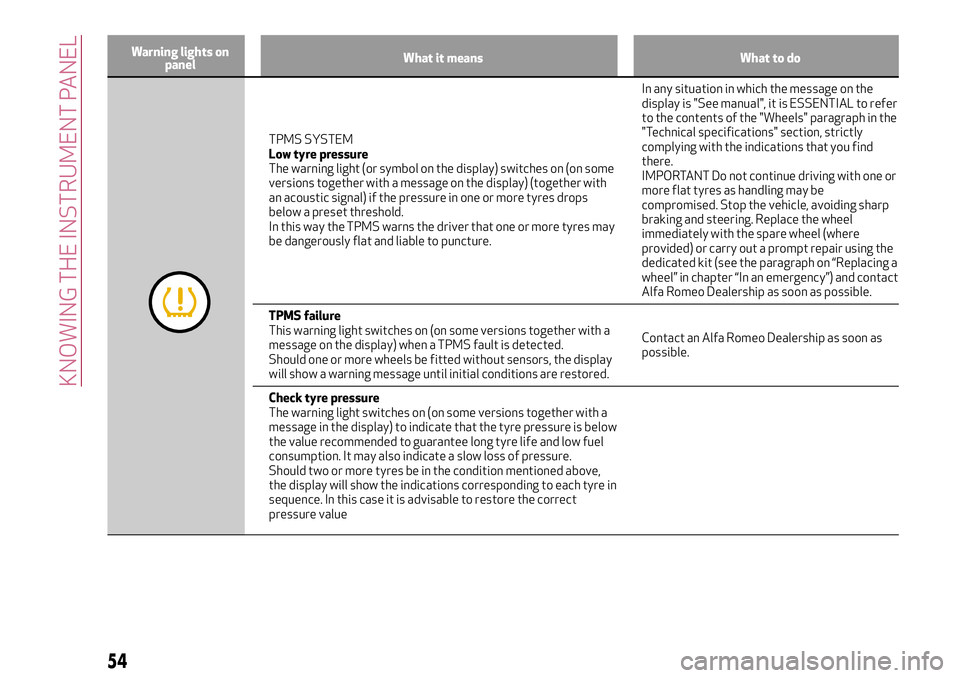
Warning lights on
panelWhat it means What to do
TPMS SYSTEM
Low tyre pressure
The warning light (or symbol on the display) switches on (on some
versions together with a message on the display) (together with
an acoustic signal) if the pressure in one or more tyres drops
below a preset threshold.
In this way the TPMS warns the driver that one or more tyres may
be dangerously flat and liable to puncture.In any situation in which the message on the
display is "See manual", it is ESSENTIAL to refer
to the contents of the "Wheels" paragraph in the
"Technical specifications" section, strictly
complying with the indications that you find
there.
IMPORTANT Do not continue driving with one or
more flat tyres as handling may be
compromised. Stop the vehicle, avoiding sharp
braking and steering. Replace the wheel
immediately with the spare wheel (where
provided) or carry out a prompt repair using the
dedicated kit (see the paragraph on “Replacing a
wheel” in chapter “In an emergency”) and contact
Alfa Romeo Dealership as soon as possible.
TPMS failure
This warning light switches on (on some versions together with a
message on the display) when a TPMS fault is detected.
Should one or more wheels be fitted without sensors, the display
will show a warning message until initial conditions are restored.Contact an Alfa Romeo Dealership as soon as
possible.
Check tyre pressure
The warning light switches on (on some versions together with a
message in the display) to indicate that the tyre pressure is below
the value recommended to guarantee long tyre life and low fuel
consumption. It may also indicate a slow loss of pressure.
Should two or more tyres be in the condition mentioned above,
the display will show the indications corresponding to each tyre in
sequence. In this case it is advisable to restore the correct
pressure value
54
KNOWING THE INSTRUMENT PANEL
Page 109 of 212
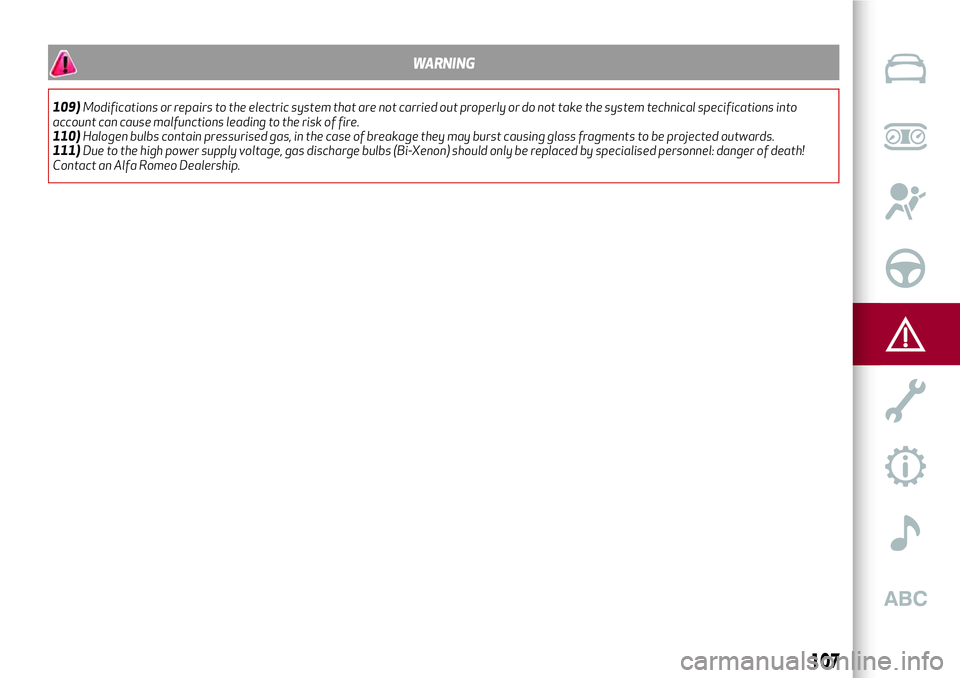
WARNING
109)Modifications or repairs to the electric system that are not carried out properly or do not take the system technical specifications into
account can cause malfunctions leading to the risk of fire.
110)Halogen bulbs contain pressurised gas, in the case of breakage they may burst causing glass fragments to be projected outwards.
111)Due to the high power supply voltage, gas discharge bulbs (Bi-Xenon) should only be replaced by specialised personnel: danger of death!
Contact an Alfa Romeo Dealership.
107
Page 121 of 212
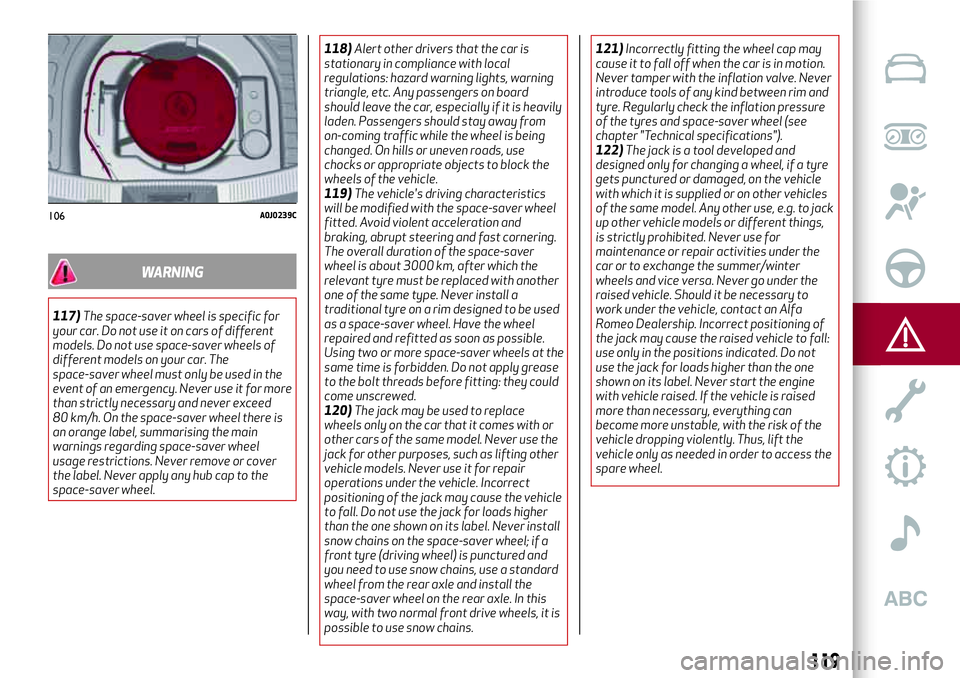
WARNING
117)The space-saver wheel is specific for
your car. Do not use it on cars of different
models. Do not use space-saver wheels of
different models on your car. The
space-saver wheel must only be used in the
event of an emergency. Never use it for more
than strictly necessary and never exceed
80 km/h. On the space-saver wheel there is
an orange label, summarising the main
warnings regarding space-saver wheel
usage restrictions. Never remove or cover
the label. Never apply any hub cap to the
space-saver wheel.118)Alert other drivers that the car is
stationary in compliance with local
regulations: hazard warning lights, warning
triangle, etc. Any passengers on board
should leave the car, especially if it is heavily
laden. Passengers should stay away from
on-coming traffic while the wheel is being
changed. On hills or uneven roads, use
chocks or appropriate objects to block the
wheels of the vehicle.
119)The vehicle's driving characteristics
will be modified with the space-saver wheel
fitted. Avoid violent acceleration and
braking, abrupt steering and fast cornering.
The overall duration of the space-saver
wheel is about 3000 km, after which the
relevant tyre must be replaced with another
one of the same type. Never install a
traditional tyre on a rim designed to be used
as a space-saver wheel. Have the wheel
repaired and refitted as soon as possible.
Using two or more space-saver wheels at the
same time is forbidden. Do not apply grease
to the bolt threads before fitting: they could
come unscrewed.
120)The jack may be used to replace
wheels only on the car that it comes with or
other cars of the same model. Never use the
jack for other purposes, such as lifting other
vehicle models. Never use it for repair
operations under the vehicle. Incorrect
positioning of the jack may cause the vehicle
to fall. Do not use the jack for loads higher
than the one shown on its label. Never install
snow chains on the space-saver wheel; if a
front tyre (driving wheel) is punctured and
you need to use snow chains, use a standard
wheel from the rear axle and install the
space-saver wheel on the rear axle. In this
way, with two normal front drive wheels, it is
possible to use snow chains.121)Incorrectly fitting the wheel cap may
cause it to fall off when the car is in motion.
Never tamper with the inflation valve. Never
introduce tools of any kind between rim and
tyre. Regularly check the inflation pressure
of the tyres and space-saver wheel (see
chapter "Technical specifications").
122)The jack is a tool developed and
designed only for changing a wheel, if a tyre
gets punctured or damaged, on the vehicle
with which it is supplied or on other vehicles
of the same model. Any other use, e.g. to jack
up other vehicle models or different things,
is strictly prohibited. Never use for
maintenance or repair activities under the
car or to exchange the summer/winter
wheels and vice versa. Never go under the
raised vehicle. Should it be necessary to
work under the vehicle, contact an Alfa
Romeo Dealership. Incorrect positioning of
the jack may cause the raised vehicle to fall:
use only in the positions indicated. Do not
use the jack for loads higher than the one
shown on its label. Never start the engine
with vehicle raised. If the vehicle is raised
more than necessary, everything can
become more unstable, with the risk of the
vehicle dropping violently. Thus, lift the
vehicle only as needed in order to access the
spare wheel.
106A0J0239C
119
Page 133 of 212
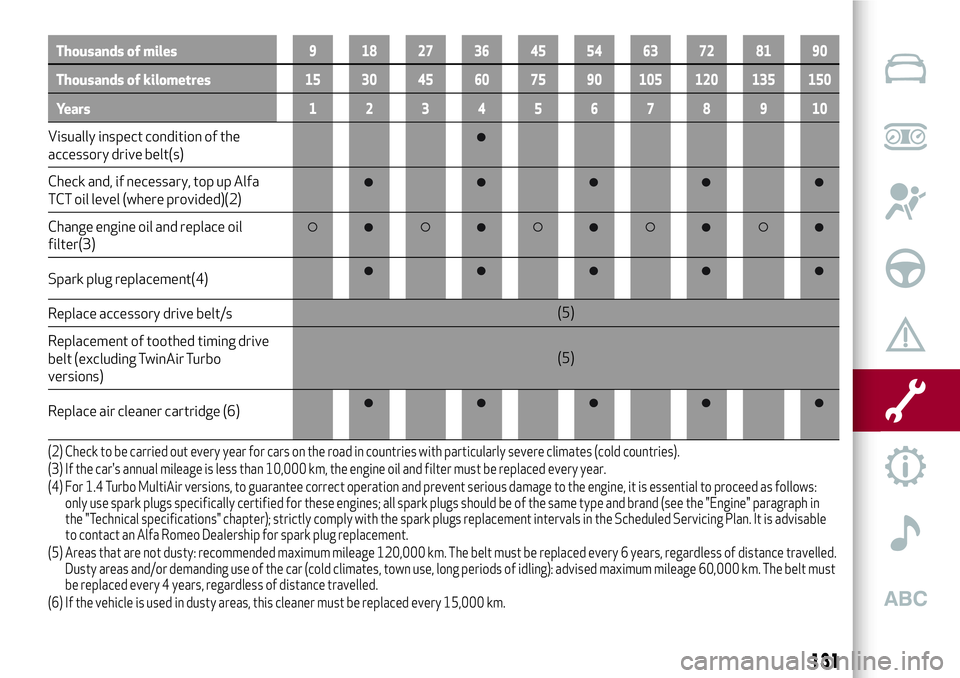
Thousands of miles9 182736455463728190
Thousands of kilometres15 30 45 60 75 90 105 120 135 150
Years12345678910
Visually inspect condition of the
accessory drive belt(s)
Check and, if necessary, top up Alfa
TCT oil level (where provided)(2)
Change engine oil and replace oil
filter(3)
Spark plug replacement(4)
Replace accessory drive belt/s(5)
Replacement of toothed timing drive
belt (excluding TwinAir Turbo
versions)(5)
Replace air cleaner cartridge (6)
(2) Check to be carried out every year for cars on the road in countries with particularly severe climates (cold countries).
(3) If the car's annual mileage is less than 10,000 km, the engine oil and filter must be replaced every year.
(4) For 1.4 Turbo MultiAir versions, to guarantee correct operation and prevent serious damage to the engine, it is essential to proceed as follows:
only use spark plugs specifically certified for these engines; all spark plugs should be of the same type and brand (see the "Engine" paragraph in
the "Technical specifications" chapter); strictly comply with the spark plugs replacement intervals in the Scheduled Servicing Plan. It is advisable
to contact an Alfa Romeo Dealership for spark plug replacement.
(5) Areas that are not dusty: recommended maximum mileage 120,000 km. The belt must be replaced every 6 years, regardless of distance travelled.
Dusty areas and/or demanding use of the car (cold climates, town use, long periods of idling): advised maximum mileage 60,000 km. The belt must
be replaced every 4 years, regardless of distance travelled.
(6) If the vehicle is used in dusty areas, this cleaner must be replaced every 15,000 km.
131
Page 144 of 212
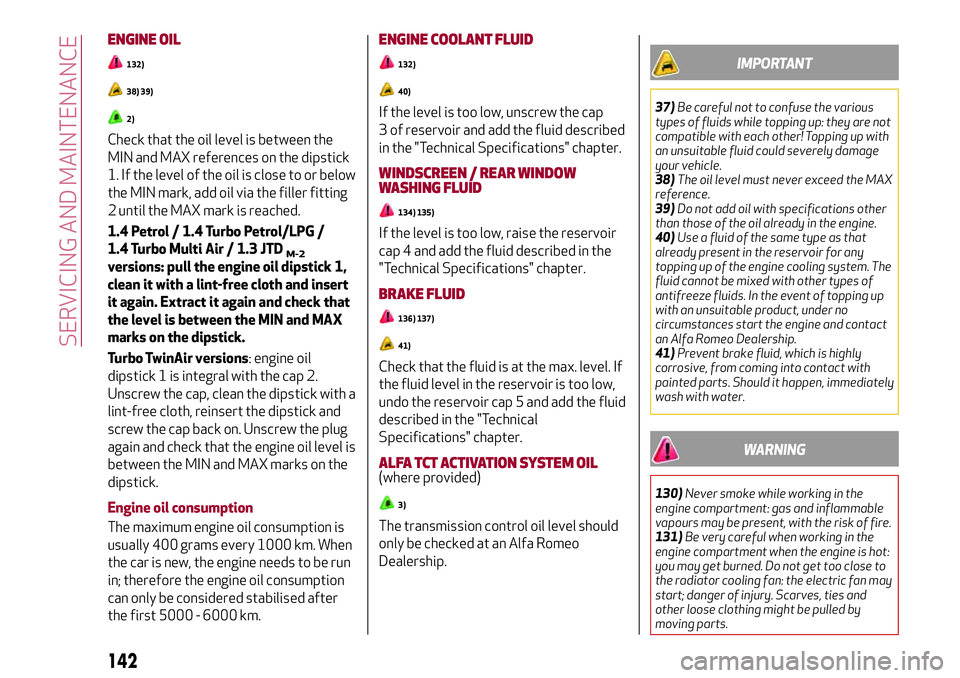
ENGINE OIL
132)
38) 39)
2)
Check that the oil level is between the
MIN and MAX references on the dipstick
1. If the level of the oil is close to or below
the MIN mark, add oil via the filler fitting
2 until the MAX mark is reached.
1.4 Petrol / 1.4 Turbo Petrol/LPG /
1.4 Turbo Multi Air / 1.3 JTD
M-2versions: pull the engine oil dipstick 1,
clean it with a lint-free cloth and insert
it again. Extract it again and check that
the level is between the MIN and MAX
marks on the dipstick.
Turbo TwinAir versions: engine oil
dipstick 1 is integral with the cap 2.
Unscrew the cap, clean the dipstick with a
lint-free cloth, reinsert the dipstick and
screw the cap back on. Unscrew the plug
again and check that the engine oil level is
between the MIN and MAX marks on the
dipstick.
Engine oil consumption
The maximum engine oil consumption is
usually 400 grams every 1000 km. When
the car is new, the engine needs to be run
in; therefore the engine oil consumption
can only be considered stabilised after
the first 5000 - 6000 km.
ENGINE COOLANT FLUID
132)
40)
If the level is too low, unscrew the cap
3 of reservoir and add the fluid described
in the "Technical Specifications" chapter.
WINDSCREEN / REAR WINDOW
WASHING FLUID
134) 135)
If the level is too low, raise the reservoir
cap 4 and add the fluid described in the
"Technical Specifications" chapter.
BRAKE FLUID
136) 137)
41)
Check that the fluid is at the max. level. If
the fluid level in the reservoir is too low,
undo the reservoir cap 5 and add the fluid
described in the "Technical
Specifications" chapter.
ALFA TCT ACTIVATIONSYSTEM OIL(where provided)
3)
The transmission control oil level should
only be checked at an Alfa Romeo
Dealership.
IMPORTANT
37)Be careful not to confuse the various
types of fluids while topping up: they are not
compatible with each other! Topping up with
an unsuitable fluid could severely damage
your vehicle.
38)The oil level must never exceed the MAX
reference.
39)Do not add oil with specifications other
than those of the oil already in the engine.
40)Use a fluid of the same type as that
already present in the reservoir for any
topping up of the engine cooling system. The
fluid cannot be mixed with other types of
antifreeze fluids. In the event of topping up
with an unsuitable product, under no
circumstances start the engine and contact
an Alfa Romeo Dealership.
41)Prevent brake fluid, which is highly
corrosive, from coming into contact with
painted parts. Should it happen, immediately
wash with water.
WARNING
130)Never smoke while working in the
engine compartment: gas and inflammable
vapours may be present, with the risk of fire.
131)Be very careful when working in the
engine compartment when the engine is hot:
you may get burned. Do not get too close to
the radiator cooling fan: the electric fan may
start; danger of injury. Scarves, ties and
other loose clothing might be pulled by
moving parts.
142
SERVICING AND MAINTENANCE
Page 153 of 212
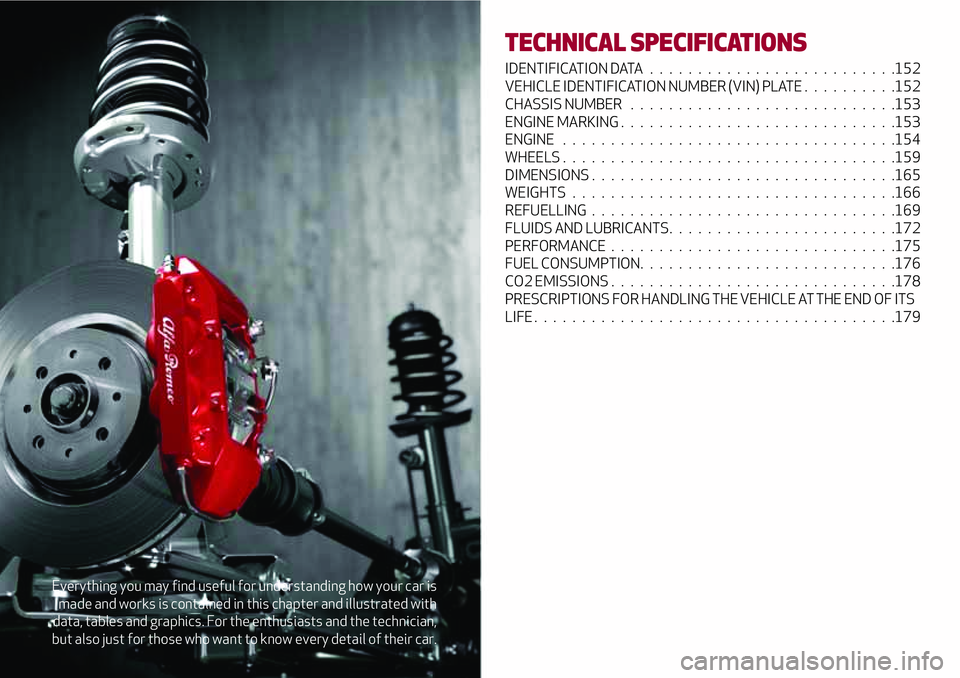
Everything you may find useful for understanding how your car is
made and works is contained in this chapter and illustrated with
data, tables and graphics. For the enthusiasts and the technician,
but also just for those who want to know every detail of their car.
TECHNICAL SPECIFICATIONS
IDENTIFICATION DATA..........................152
VEHICLE IDENTIFICATION NUMBER (VIN) PLATE . . . . ......152
CHASSIS NUMBER . . . . . .......................153
ENGINE MARKING . . . . . ........................153
ENGINE...................................154
WHEELS...................................159
DIMENSIONS . . ..............................165
WEIGHTS..................................166
REFUELLING................................169
FLUIDS AND LUBRICANTS. . . .....................172
PERFORMANCE . . . . . . . . . . . . . .................175
FUEL CONSUMPTION. . . . . ......................176
CO2 EMISSIONS . . . . ..........................178
PRESCRIPTIONS FOR HANDLING THE VEHICLE AT THE END OF ITS
LIFE......................................179
Page 154 of 212

IDENTIFICATION DATA
The identification data of the vehicle are:
VIN plate;
Chassis marking;
Bodywork paint identification plate;
Engine marking.
VEHICLE IDENTIFICATION
NUMBER (VIN) PLATE
This plate is fitted to the engine
compartment front crossmember and
contains the following identification data
fig. 129:
TO: Name of Manufacturer
B: Type-approval number
C: Vehicle type identification code
D: Chassis number
E: Maximum permitted weight of vehicle
fully laden
F: Maximum permitted weight of vehicle
fully laden plus trailer
G: Maximum permitted weight on front
axle
H: Maximum permitted weight on second
(rear) axle
I: Engine type
L: Bodywork version codeM: Spares number
N: Smoke opacity index (for diesel
engines)
129A0J0161C
152
TECHNICAL SPECIFICATIONS
Page 156 of 212

ENGINE
GENERAL INFORMATION Turbo TwinAir 105 HP Turbo TwinAir 100 HP(*)
Engine code 199B6000 199B7000
CycleOtto Otto
Number and position of cylinders 4 in line 4 in line
Piston bore and stroke (mm) 80.5 × 86 72.0 × 84.0
Total displacement (cm³) 875 875
Compression ratio 10 10
NATURAL DYNAMIC
Maximum power (EC) (kW) 72 77 73.5
Maximum power (EEC) (HP) 98 105 100
corresponding engine speed (rpm) 5750 5500 5500
Maximum torque (EC) (Nm) 120 145 145
Maximum torque (EC) (kgm) 12.2 14.8 14.8
corresponding engine speed (rpm) 1750 2000 2100
Spark plugs NGK ILKR9G8 NGK ILKR9G8
FuelUnleaded petrol 95 R.O.N. (EN
228 specifications)Unleaded petrol 95 R.O.N. (EN
228 specifications)
(*) Version for specific markets
154
TECHNICAL SPECIFICATIONS
Page 158 of 212

GENERAL INFORMATION 1.4 Turbo MultiAir 135 HP 1.4 Turbo Multi Air 135/140 HP TCT
Engine code 955A2000955A7000 (*)
955B1000 (**)
Cycle Otto Otto
Number and position of cylinders 4 in line 4 in line
Piston bore and stroke (mm) 72.0 × 84.0 72.0 × 84.0
Total displacement (cm³) 1368 1368
Compression ratio 9.8 9.8
Maximum power (EC) (kW) 99 99 (*) / 103 (**)
Maximum power (EEC) (HP) 135 135 (*) / 140 (**)
corresponding engine speed (rpm) 5000 5000
NATURAL DYNAMIC NATURAL DYNAMIC
Maximum torque (EC) (Nm) 190 206 230 250
Maximum torque (EC) (kgm) 19.3 21 23.4 25.5
corresponding engine speed (rpm) 4250 1750 2250 2500
Spark plugs NGK IKR9F8 NGK IKR9J8
FuelUnleaded petrol 95 R.O.N. (EN
228 specifications)Unleaded petrol 95 R.O.N. (EN
228 specifications)
(*) 1.4 Turbo Multi Air 135 HP TCT version (where provided)
(**) 1.4 Turbo Multi Air 140 HP TCT version
156
TECHNICAL SPECIFICATIONS